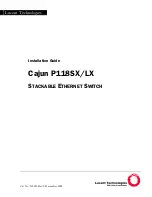
Dell EMC switches are labeled in accordance with European Directive 2002/96/EC concerning waste electrical and electronic equipment
(WEEE). The Directive determines the framework for the return and recycling of used appliances as applicable throughout the European
Union. This label is applied to various products to indicate that the product is not to be thrown away, but rather reclaimed upon end of life
per this Directive.
Figure 12. The European WEEE symbol
In accordance with the European WEEE Directive, electrical and electronic equipment (EEE) is to be collected separately and to be
reused, recycled, or recovered at end of life. Users of EEE with the WEEE marking per Annex IV of the WEEE Directive, as shown above,
must not dispose of end of life EEE as unsorted municipal waste, but use the collection framework available to customers for the return,
recycling and recovery of WEEE. Customer participation is important to minimize any potential effects of EEE on the environment and
human health due to the potential presence of hazardous substances in EEE.
Dell EMC products, which fall within the scope of the WEEE, are labeled with the crossed-out wheelie-bin symbol, as shown above, as
required by WEEE.
For information on Dell EMC product recycling offerings, see the WEEE Recycling instructions on Support. For more information, contact
the Dell EMC Technical Assistance Center.
Agency compliance
The VEP1405 is designed to comply with the following safety and agency requirements:
USA Federal Communications Commission statement
CAUTION:
The use of external signal amplifiers in-line with the transceiver antennas is strictly prohibited.
This device complies with Part 15 of the FCC Rules. Operation is subject to the following two conditions:
1) This device may not cause harmful interference, and (2) this device must accept any interference received, including
interference that may cause undesired operation.
This equipment has been tested and found to comply with the limits for a Class A digital device, pursuant to Part 15
of the
FCC Rules.
These limits are designed to provide reasonable protection against harmful interference in a residential installation. This equipment
generates, uses and can radiate radio frequency energy and, if not installed and used in accordance with the instructions, may cause
harmful interference to radio communications. However, there is no guarantee that interference will not occur in a particular installation. If
this equipment does cause harmful interference to radio or television reception, which can be determined by turning the equipment off
and on, the user is encouraged to try to correct the interference by one of the following measures.
Reorient or relocate the receiving antenna.
Increase the separation between the equipment and receiver.
Connect the equipment into an outlet on a circuit different from that to which the receiver is connected.
Consult the dealer or an experienced radio/TV technician for help.
FCC Caution:
Any changes or modifications not expressly approved by the party responsible for compliance could void the user's authority to operate
this equipment.
This transmitter must not be co-located or operating in conjunction with any other antenna or transmitter.
14
Specifications






































